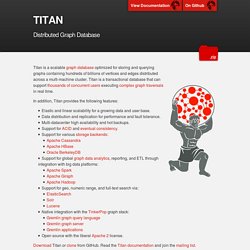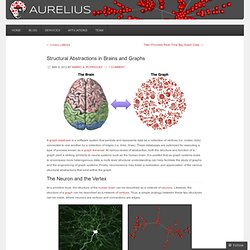Graph Databases
> Appukp
> Tech
> Databases
> Other DBMS
Web Graph Database. Scaling Apache Giraph to a trillion edges. Facebook’s trillion-edge, Hadoop-based and open source graph-processing engine. People following the open source Giraph project likely know that Facebook was experimenting with it, and on Wednesday the company detailed just how heavily it’s leaning on Giraph . Facebook scaled it to handle trillions of connections among users and their behavior, as the core of its Open Graph tool. Oh, and now anyone can download Giraph, which is an Apache Software Foundation project, with Facebook’s improvements baked in. Graphs, you might recall from our earlier coverage, are the new hotness in the big data world .
Giraph - Welcome To Apache Giraph!
Apache Giraph. References[edit] External links[edit] Official website.

Facebook's Graph Search puts Apache Giraph on the map. Move over Hadoop, there is another highly scalable data-processing powerhouse in town: Apache Giraph.

Facebook is using the technology to bring a new style of search to its billion users. When Facebook built its Graph Search service, the social-networking company picked Giraph over other social graphing technologies—such as the Hadoop-based Apache Hive and GraphLab—because of Giraph’s speed and immense scalability.
Neo4j System Properties. Titan System Properties. Titan: Distributed Graph Database. Titan is a scalable graph database optimized for storing and querying graphs containing hundreds of billions of vertices and edges distributed across a multi-machine cluster.

Titan is a transactional database that can support thousands of concurrent users executing complex graph traversals in real time. In addition, Titan provides the following features: Download Titan or clone from GitHub. Read the Titan documentation and join the mailing list. <dependency><groupId>com.thinkaurelius.titan</groupId><artifactId>titan-core</artifactId><version>1.0.0</version></dependency><!
Home · thinkaurelius/titan Wiki. Paper: Graph Databases and the Future of Large-Scale Knowledge Management. Titan Provides Real-Time Big Graph Data « Aurelius. August 6, 2012 by Marko A.

Rodriguez The presentation to follow discusses the simulation’s social graph structure, the types of processes executed on that structure, and the various runtime analyses of those processes under normal and peak load. The presentation concludes with a discussion of the Amazon EC2 cluster architecture used and the associated costs of running that architecture in a production environment.
Structural Abstractions in Brains and Graphs « Aurelius. A graph database is a software system that persists and represents data as a collection of vertices (i.e. nodes, dots) connected to one another by a collection of edges (i.e. links, lines).

These databases are optimized for executing a type of process known as a graph traversal. At various levels of abstraction, both the structure and function of a graph yield a striking similarity to neural systems such as the human brain. It is posited that as graph systems scale to encompass more heterogenous data, a multi-level structural understanding can help facilitate the study of graphs and the engineering of graph systems. Finally, neuroscience may foster a realization and appreciation of the various structural abstractions that exist within the graph. The Neuron and the Vertex The human brain is believed to be composed of approximately 100 billion neurons and 1 quadrillion connections (1 quadrillion is 1000 trillion).
The Area and the Motif The Region and the Subgraph Conclusion Acknowledgement. Need a graph database like Twitter is built on? @neo4j delivers, @emileifrem tells why. Labs — MarkLogic Developer Community. Labs is the home for experimental MarkLogic and MarkLogic-related work.

We make these projects available in the hopes that you may find them useful. In turn, we hope you will share your thoughts, opinions, and ideas on these projects with us. MLJS is a Javascript library for connecting to MarkLogic from both Browser JS and Node.JS Sensible defaults so you can get started quickly Minimum prior MarkLogic knowledge required Browser widgets so you can quickly get an application running Built on top of the REST API Browse Git Repository » MarkLogic Converter for MongoDB® This Java-based tool reads JSON data from the mongodump tool and loads it into MarkLogic.
Don't Let Architecture Astronauts Scare You. By Joel Spolsky Saturday, April 21, 2001 When great thinkers think about problems, they start to see patterns.

The Economics of Software Quality: Capers Jones,Olivier Bonsignour: 9780132582209: Amazon.com. Michael Feathers. Control structures have been around nearly as long as programming but it's hard for me to see them as more than an annoyance. Over and over again, I find that better code has fewer if-statements, fewer switches, and fewer loops. Often this happens because developers are using languages with better abstractions.
They aren't consciously trying to avoid control structures but they do. If we are working in an object-oriented language, we can replace switch-statements with polymorphism. The same trick works well for if-statements too, but it can be overkill in simple cases. The problem with control structures is that they often make it easy to modify code in bad ways. If ... ... else ... end. Scaling Machine Learning. Knowledge – Inside Search – Google. World's Leading Graph Database » What is Neo4j?







